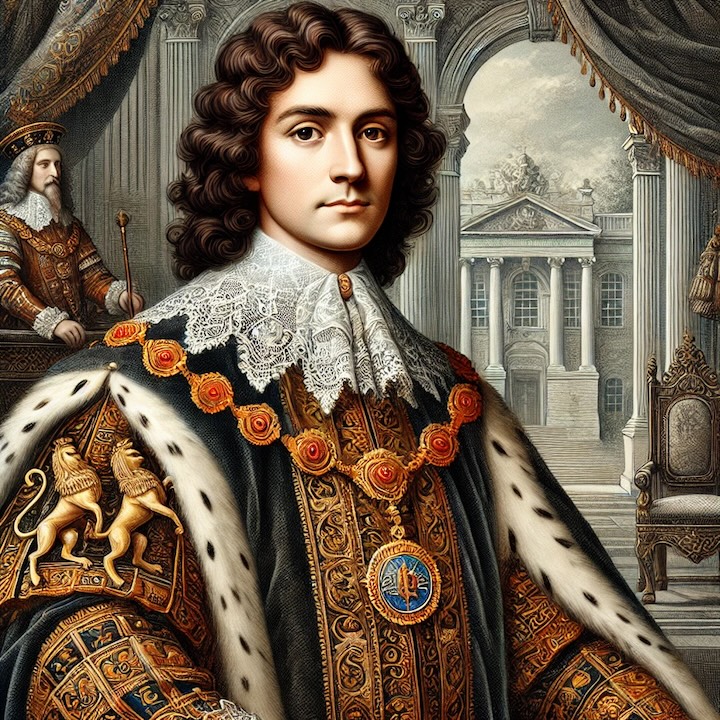
Son of the executed Charles I, he was crowned in Scotland in 1651. Attempted to wrest control of England from Oliver Cromwell; his failure resulted in exile to France and Holland. In 1660, Charles was able to return to England. His rule was marked by religious discord as anti-Catholic sentiment rocked the country. Though sympathetic to Roman Catholicism, Charles could only acknowledge his faith on his deathbed. His niece, Mary, married William of Orange, thus assuring Protestant succession to the throne..
Charles II, born on May 29, 1630, was the son of Charles I of England and Henrietta Maria of France. He was the monarch of England, Scotland, and Ireland, ruling from the Restoration of the monarchy in 1660 until his death in 1685. His reign is notable for the restoration of the monarchy after a period of republican rule under Oliver Cromwell, and for the complex and often turbulent politics of his time.
Charles was born during a period of rising tension between his father, King Charles I, and Parliament, which eventually led to the English Civil War. The conflict, which lasted from 1642 to 1651, resulted in the defeat of the Royalist forces and the execution of Charles I in 1649. Charles II, then only 19 years old, was declared king by the Scots and led a military campaign to reclaim the throne. However, his forces were defeated at the Battle of Worcester in 1651, forcing him into exile in France and the Netherlands for nearly a decade.
During his exile, Charles lived in relative poverty and had to rely on the goodwill of European monarchs, particularly his cousin, Louis XIV of France. He spent these years attempting to garner support for his restoration to the English throne, maintaining contact with Royalist supporters in England and Scotland. His fortunes changed with the death of Oliver Cromwell in 1658 and the subsequent collapse of the Commonwealth government. The political vacuum created by Cromwell's death, coupled with the increasing unpopularity of the republican regime, led to the restoration of the monarchy in 1660.
Charles II was invited back to England by Parliament in what is known as the Restoration, and he was crowned king on April 23, 1661. His return was marked by widespread public celebration, as many were relieved to see the end of the strict Puritan rule that had characterized the Commonwealth period. Charles, known for his charm and wit, quickly became popular, but his reign was not without challenges.
One of the significant issues Charles faced was the question of religion. England was deeply divided between Protestants and Catholics, and Charles' own religious sympathies were a matter of suspicion. Although outwardly Protestant, Charles was suspected of having Catholic leanings, particularly after his secret treaty with Louis XIV in 1670, in which he promised to convert to Catholicism in exchange for financial support. This treaty, however, remained a secret during his lifetime.
Charles II's reign also saw significant developments in foreign policy. He pursued a pro-French policy, largely influenced by his need for financial support from Louis XIV. This led to involvement in several wars, including the Second and Third Anglo-Dutch Wars (1665-1667 and 1672-1674). The wars were costly and largely unsuccessful, which, combined with the Great Plague of 1665 and the Great Fire of London in 1666, led to considerable public dissatisfaction.
Despite these challenges, Charles managed to maintain his throne and navigate the complex political landscape of Restoration England. His reign also saw the development of the modern British political system, with the emergence of political parties, the Whigs and Tories, which debated issues such as royal prerogative and the rights of Parliament.
Charles II died on February 6, 1685, at the age of 54, after suffering a stroke. On his deathbed, he converted to Catholicism, confirming the suspicions that had followed him throughout his reign. He was succeeded by his brother, James II, whose openly Catholic policies would eventually lead to the Glorious Revolution of 1688.
Charles II's reign was a period of significant change and challenge for England. Known as the "Merry Monarch" for his lively court and numerous mistresses, Charles was also a shrewd and pragmatic ruler who managed to restore and maintain the monarchy during a turbulent time in British history. His legacy is a complex one, marked by both the restoration of royal authority and the seeds of future constitutional developments that would shape modern Britain.
 >
>